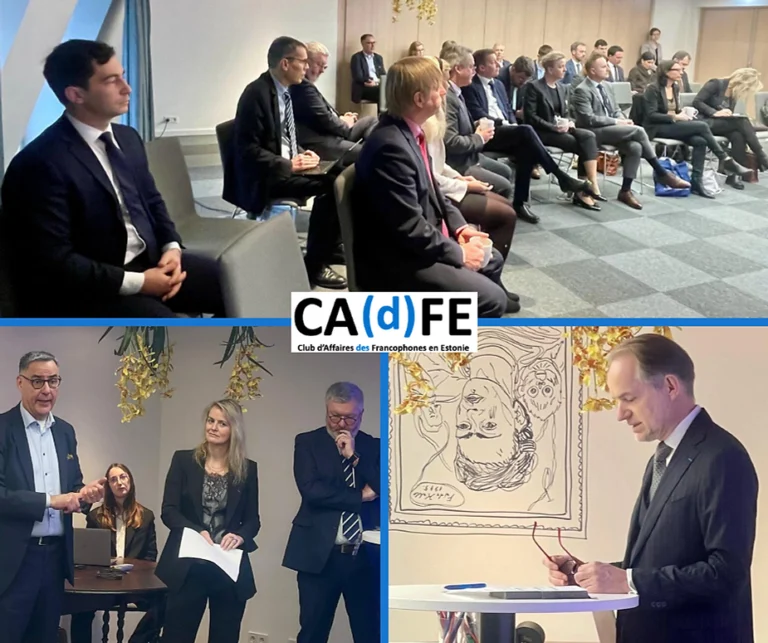
Nuclear Energy in Estonia: Crossroads at the Franco-Finnish Seminar

A few days ago, on Wednesday February 21, 2024, CAdFE was invited to take part in a seminar on nuclear energy in Estonia, orchestrated by the French Embassy.The aim of the seminar was to feed the debate through the sharing of French and Finnish experiences.
Here are a few extracts from the interesting exchanges between experts that took place during the morning.
The international context of nuclear power, with 56 reactors under construction worldwide, was presented, highlighting the significant share in Europe and France.
Nuclear power accounts for 25% of the EU’s energy mix, a response to the zero-carbon challenges set by the EU for 2050.
France was open to cooperation with Estonia, while emphasizing its respect for the Baltic country’s sovereignty.
Estonian Perspectives and Presentation of the Nuclear Energy Working Group Report
The aim of this interministerial group, formed in 2021, is to provide the best knowledge on the subject to enable the country to decide on the potential role of nuclear power in achieving climate goals and ensuring energy security in Estonia.
The final decision on whether or not to build a nuclear power plant will be a societal choice determined by the vote of parliamentarians in 2024.
However, the need for qualified experts was highlighted, implying an initial reliance on foreign experts.
The IAEA has also given a positive opinion on the construction of a nuclear power plant in Estonia.
The research budget for ensuring scientific and technological advances in the field of nuclear energy amounts to 577,000 euros, of which more than a third, i.e. 209,000 euros, comes from European funds dedicated to research and development.
How much does such a project cost?
This compensation will arrive during the power plant’s construction phase, and will come from the state’s income from labor taxes and the impact on the regional economy resulting from construction activities.
When the plant is built – some 11 years after the launch of the nuclear program – the tax revenues received by the state would exceed expenditure by at least 5.5 million euros in the worst-case scenario, or 19 million in the most likely case.
This allocation is still difficult to estimate precisely, and will be used to cover rescue and technical capacity-building measures.
In the event of failure, the importance of exploring other energy sources, notably hydrogen, was stressed.
The EDF representative assured the audience that the French company would be ready to support the Estonian government in this endeavor.
It was stressed that the role of the private sector in financing the project should not be underestimated, building on its success in other fields, such as space programs.
Finally, the Swedish Ambassador to Estonia, H.E. Ingrid Tersman, suggested the creation of a regional training complex for nuclear experts with our Nordic neighbors, offering an innovative perspective to regional cooperation.
Energy Security, Energy Sovereignty and Energy Sobriety: The Pillars of a Sustainable French Strategy
She stresses the need to prioritize the production of green electricity to support the development of new green industries.
Dependence on China in renewable energies was also singled out, as was the decision to leave this sector to the private sector.
Maisonneuve insisted on the importance for Europe of breaking away from Russia by renewing nuclear power, underlining the geopolitical stakes and the security of the electricity system.
The objective of reducing electricity consumption was highlighted, supported by a survey carried out by RTE (Réseau de Transport d’Électricité, an EDF subsidiary) on the evolution of electricity consumption and production up to 2050. Three different scenarios are envisaged, but the conclusion underlined that without nuclear power, carbon neutrality will not be achievable.
This approach is supported by two major economic plans, “France Relance” and “France 2030”.
However, speakers pointed to the lack of synergy and discussion at European level on the subject, indicating a greater need for cooperation.
Finland shared its experience with increased energy production coupled with reduced consumption, pointing out that the issue of reduction is not receiving sufficient attention.
On the other hand, the French initiative on energy efficiency in buildings and industry caught the public’s attention, with examples such as 1 euro insulation, and lowering the temperature in public buildings to 19°C, which has resulted in a 10% reduction in electricity consumption.
Nuclear Waste Management Strategies: Finnish and French Experiences in Transparency, Acceptance and Implications
With experience spanning 44 years, the process, including site selection, excavation and licensing, culminated in the construction of a nuclear waste processing site located on the island of Olkiluoto in Finland.
The storage capacity is 6,500 tonnes of uranium. The current public acceptance rate of 80% is attributed to a policy of transparency, reinforced by communication campaigns and, in particular, an active presence on social networks, notably with a campaign on the EU’s green taxonomy, illustrated by hashtags such as #rocktorock.
As ambassadors, employees contribute to the site’s positive image.
Posiva Solutions presents a complete solution for the management and storage of nuclear waste.
The head of the International Atomic Energy Agency praised the quality of the project.
Solente emphasizes the governance and interactions between stakeholders, highlighting the involvement of all players in this process, demonstrating a well-defined strategy.
The success of such partnerships is above all a political issue, with questions raised as to which countries would be willing to host such structures.
Experience in France and Finland has shown that the proximity of the population to a treatment site influences their willingness to accept a new center, with greater acceptance coming from those who are better informed.
Public perception of nuclear energy and the financial impact on local communities
His work at the OECD focuses on research into nuclear safety, technology and policy.
He underlines the importance of COOP28, noting that the issue of nuclear power has been raised for the first time in bilateral cooperation between countries using nuclear power since the beginning of its use.
He underlined the importance of the informal discussion that had emerged, highlighting a trend towards a more rational approach to nuclear energy.
This shift in perception indicates a significant change in the way people approach and understand nuclear issues. The ambassador also recalled that France stands ready to support Estonia in the decision it will take, underlining the ongoing commitment to cooperation and sharing of expertise between the two nations.
He expressed the hope that this growing rationality will continue to guide debates and decision-making in the field of nuclear energy, fostering a balanced and informed understanding of this crucial energy source for the future.
Contact us!

✉ contact@ccife.ee
CCI France-Estonie is proudly affiliated to CCI France International, the worldwide network of French Chambers of Commerce and Industry.
Download the CCIFI Connect application
Accelerate your business thanks to the 1st private network of French companies in 94 countries: 119 chambers | 33,000 companies | 4,000 events | 300 committees | 1,200 exclusive advantages
Exclusively for members of the CCI Françaises à l’International, discover the CCIFI Connect app.
Website
Stay informed!
Made with ❤ by Cycoma
Copyright 2024 Chambre de Commerce et d’Industrie France Estonie
Contact us!

✉ contact@ccife.ee
CCI France-Estonie is proudly affiliated to CCI France International, the worldwide network of French Chambers of Commerce and Industry.
Download the CCIFI Connect application
Accelerate your business thanks to the 1st private network of French companies in 94 countries: 119 chambers | 33,000 companies | 4,000 events | 300 committees | 1,200 exclusive advantages
Exclusively for members of the CCI Françaises à l’International, discover the CCIFI Connect app.
Website
Stay informed!
Made with ❤ by Cycoma
Copyright 2024 Chambre de Commerce et d’Industrie France Estonie



